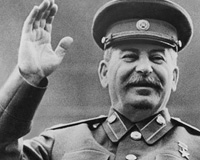Josef Vissarionovich Dzhugashvili, the Soviet political leader was born in 1879 in Guri of Georgia. His father was a shoemaker. He attended theological seminary near Tiflis. In 1898, he joined Social Democratic party of Caucasus. Following the party split into two Bolshevik and...
Josef Vissarionovich Dzhugashvili, the Soviet political leader was born in 1879 in Guri of Georgia. His father was a shoemaker. He attended theological seminary near Tiflis. In 1898, he joined Social Democratic party of Caucasus. Following the party split into two Bolshevik and Manshevik wings (1903), he sided with the latter (Lenin's comrades). From 1902 to 1913, he was arrested five times but always escaped the prison. He was exiled to Siberia for ever, but in 1917, he was released under a general amnesty. Due to playing an important role between the first and the second revolution, he was entitled the steel man by Lenin hence Stalin in Russian. In 1922, he was the general secretary of the Communist party and after Lenin's death he took the power in his hands.
In 1926, he ratified his known as Stalin Constitution and eliminated his two party rivals, Trotsky and Zinoviev. In 1928, he put an end to Lenin's new economic policies and developed the "Five year plans" for industrializing and communizing of the country at the expense of thousands of people's lives. Stalinism is a symbol of hard times of his strangulation.
He became prime minister in 1941, and in the same time, following the German invasion of Russia, he became commissar for defence and thus took over supreme directions of military operations.
In Tehran conference, he brought forth the question Iran's northern, and the Persian Gulf oil fields and proposed the division of these resources. He issued an order for the exploration of northern Iran's oil. Then he added fuel to the nationalistic feelings of Azaris on two sides of Iran-o Soviet border and organized an Azerbaijanian separatist movement. The history of this movement from December 1945-1946 was enough to show that the movement had no popular roots.
The later events proved that Stalin had no hesitation in sacrificing of the separatist's leaders who had devoted themselves to him. Following the second world war, he took up iron curtain policy, and there was a cold war between the Soviet and the U.S. for many years. He died in March 1953 for cerebral hemorrhage. Khroshchef succeeded him as the general secretary of the Communist party and charged Stalin with violence and encouraging of personalism.
Among Stalin's works, we may refer to Leninism, Questions of Leninism and The Patriotic war of the Soviet Union.
https://iichs.ir/vdcf.jdyiw6dex7raw.html
iichs.ir/vdcf.jdyiw6dex7raw.html
